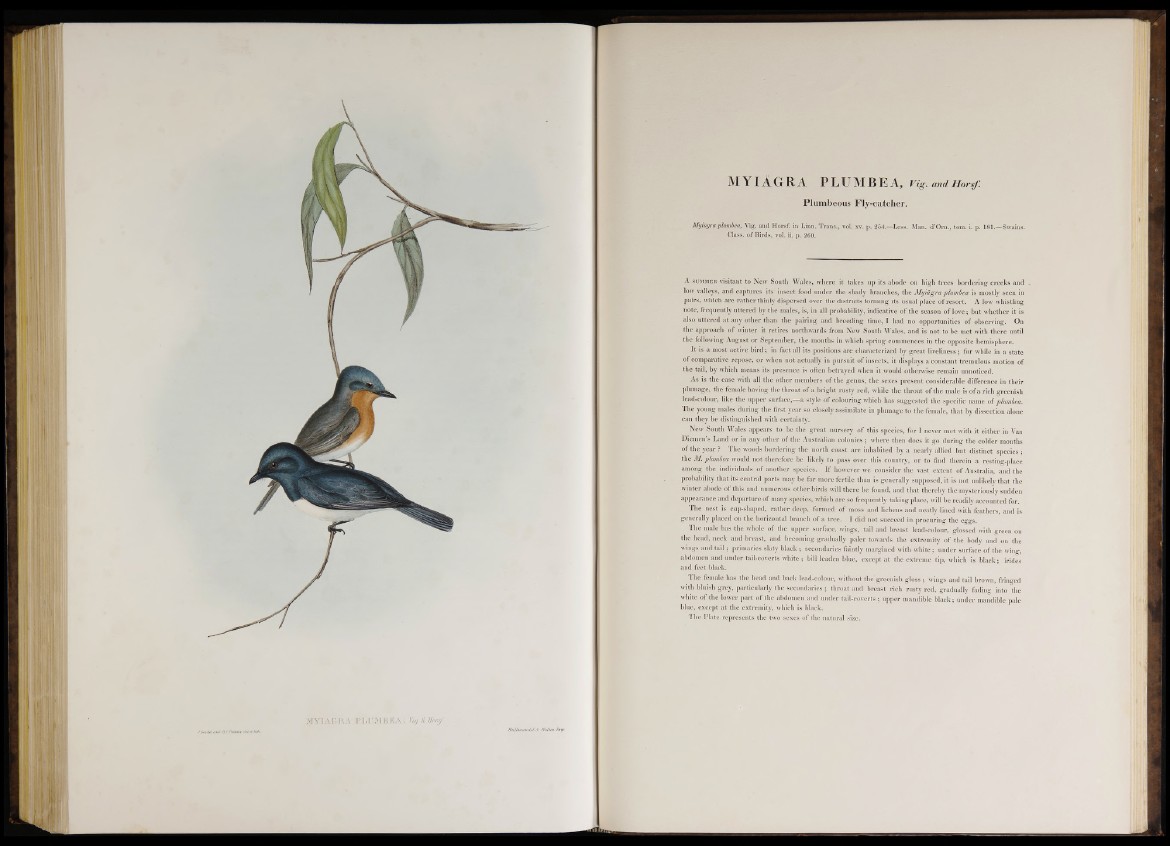
MYIAGRA PLUMBEA, n g . andHorsf.
Plumbeous Fly-catcher.
Myi&gra phmbea, Vig. and Horsf. in Linn. Trans., vol. xv. p. 254.—Less. Man. d’Om., tom. i. p. 181.—Swains.
Class, of Birds, vol. ii. p. 260.
A s u m m e r , visitant to New South Wales, where it takes up its abode on high trees bordering creeks and
low valleys, and captures its- insect food under the shady branches, the Myiagra plumbea is mostly seen in
pairs, which are rather thinly dispersed over the districts forming its usual place of resort. A low whistling
note, frequently uttered by the males, is, in all probability, indicative o f the season of love; but whether it is
also uttered at any other than the pairing and breeding time, I had no opportunities of observing. On
the approach o f winter it retires northwards from New South Wales, and is not to be met with there until
the following August or September, the months in which spring commences in the opposite hemisphere.
It is a.most active bird; in fact all its positions are characterized by great liveliness; for while in a state
of comparative repose, or when not actually in pursuit o f insects, it displays a constant tremulous motion of
the tail, by which means its presence is often betrayed when it would otherwise remain unnoticed.
As is the case with all the other members o f the genus, the sexes present considerable difference in their
plumage, the female having the throat o f a bright rusty red, while the throat of the male is o f a rich greenish
lead-colour, like the upper surface,—a style o f colouring which has suggested the specific name of plumbea.
The young males during the first year so closely assimilate in plumage to the female, that by dissection alone
can they be distinguished with certainty.
New South Wales appears to be the great nursery o f this species, for I never met with it either in Van
Diemen’s Land or in any other o f the Australian colonies; where then does it go during the colder months
o f the year ? The woods bordering the north coast are inhabited by a nearly allied but distinct species ;
the M. plumbea would not therefore be likely to pass over this country, or to find therein a resting-place
among the individuals o f another species. If however we consider the vast extent of Australia, and the
probability that its central parts may be far more fertile than is generally supposed, it is uot unlikely that the
winter abode o f this and numerous other birds will there be found, and that thereby the mysteriously sudden
appearance and departure of many species, which are so frequently taking place, will be readily accounted for.
The nest is cup-sliaped, rather deep, formed o f moss and lichens and neatly lined with feathers, and is
generally placed on the horizontal branch of a tree. I did not succeed in procuring the eggs.
The male has the whole o f the upper surface, wings, tail and breast lead-colour, glossed with green on
the head, neck and breast, and becoming gradually paler towards the extremity o f the body and on the
wings and ta il; primaries slaty black ; secondaries faintly margined with white; under surface o f the win«*-,
abdomen and under tail-coverts white; bill leaden blue, except at the extreme tip, which is black; irides
and feet black.
The female has the head and back lead-colour, without the greenish gloss ; wings and tail brown, fringed
with bluish grey, particularly the secondaries; throat and breast rich rusty red, gradually fading into the
white of the lower part of the abdomen and under tail-coverts ; upper mandible black; under mandible pale
blue, except at the extremity, which is black.
The Plate represents the two sexes of the natural size.